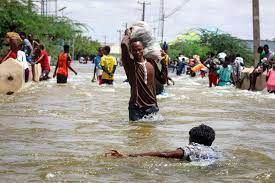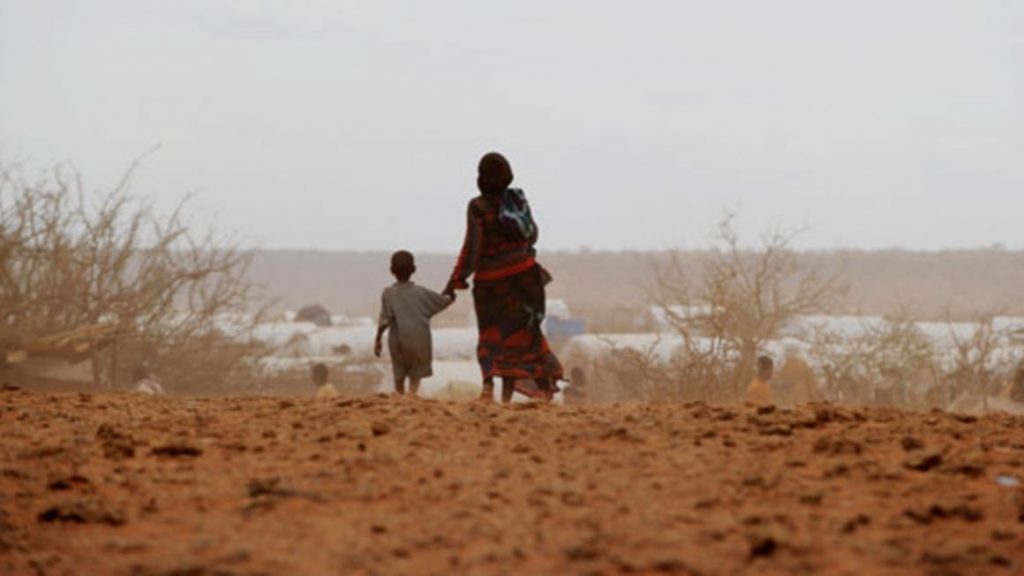By Hussien Mohamed Yusuf
Somalia has a history of recurring droughts that have had severe consequences for the country’s population, particularly for pastoral and agro-pastoral communities. Droughts in Somalia are often linked to climate variability, including the El Niño and La Niña phenomena, and they are exacerbated by factors such as deforestation, land degradation, and limited access to water resources.

A nation marked by a history of climatic extremes, is facing a perilous journey from drought to flooding. This East African nation has long been grappling with the harsh realities of a changing climate, witnessing cycles of drought that cripple agriculture and exacerbate food insecurity. However, in a twist of fate, Somalia is now grappling with the flip side of the climate coin – flooding. This unforeseen shift has plunged the country into a complex web of challenges, testing the resilience of its people and infrastructure.
Somalia has a longstanding history of droughts, with periodic episodes stretching back decades. Nomadic communities, heavily dependent on livestock, find their herds dwindling as water sources dry up and vegetation becomes scarce. Agriculture, too, is severely impacted, leading to food shortages that often transform into famines. The harsh reality is that the livelihoods of many Somalis are intricately linked to the unpredictability of rainfall, making drought a recurring nightmare.
The impacts of drought extend beyond immediate food scarcity. Displacement becomes a harsh reality as communities are forced to abandon their homes in search of water and sustenance. The lack of water also contributes to the spread of waterborne diseases, adding another layer of suffering to an already vulnerable population.
Flooding: An Unprecedented Challenge
In a cruel irony, Somalia is now grappling with a different face of climate crisis – flooding. While droughts have been a historical norm, the frequency and intensity of floods are on the rise, catching communities off guard. The same regions that faced parched landscapes are now inundated with water, submerging homes, displacing families, and wreaking havoc on infrastructure. Towns in Gedo Region have lost bridges and are now having difficult in making any possible assistance to the people in the same village and town.
The causes of the flooding are multifaceted, ranging from extreme weather events to deforestation and inadequate urban planning. Cyclones in the Indian Ocean and the warming of the Indian Ocean itself contribute to erratic weather patterns, resulting in heavy rains that the arid landscapes of Somalia are ill-equipped to handle. Deforestation, driven by both natural factors and human activities, reduces the land’ Flooding in Somalia has profound and multifaceted impacts on pastoral and agro-pastoral communities, whose livelihoods are intricately tied to the land and livestock. These communities, often residing in vulnerable areas, face unique challenges as they navigate the dual crises of droughts and floods.
Livestock Loss and Displacement:
Pastoral communities heavily depend on livestock for their sustenance and livelihoods. Flooding brought a direct threat to the well-being of animals, leading to loss through drowning, diseases, or lack of access to adequate grazing lands. We have seen and observed pastoral communities who has been badly affected by the flooding complaining about the lack of feed for their livestock.
Floods forced pastoralists to move their herds to higher ground, in case they may have survived disrupting established migration patterns. This displacement not only disrupted the animals’ natural behavior but also puts additional pressure on already scarce resources.
Agricultural Devastation:
Agro-pastoral communities, engaged in both livestock rearing and agriculture, faced significant challenges as floods destroyed crops and inundated fields. This not only resulted in immediate food shortages but also impacted future harvests, disrupting the agricultural cycle. We have been watching from TV Stations how it has devastated and all villages are immersed under water. The author of this piece has flied over Jubba river last week while coming back from a short mission to Mogadishu and has seen firsthand devastation and inundation of farms under water.
Floodwaters will lead to soil erosion, washing away fertile topsoil essential for agriculture. This further depletes the land’s productivity, making it harder for communities to recover and resume agricultural activities in the future.
Water Contamination and Health Risks:
Floods often contaminate water sources with pollutants, posing a severe risk to both livestock and human populations. This contamination can lead to the spread of waterborne diseases, creating a public health crisis in already vulnerable communities.

Agro-pastoral communities are now exposed to heightened health risks, including waterborne diseases like cholera and increased incidences of malnutrition due to disrupted food and water supplies.
Infrastructure Damage and Access Challenges:
Floods has already damaged crucial infrastructure such as roads, bridges, and water supply systems. This hinders the mobility of pastoralists and the transportation of goods, exacerbating the isolation of already remote communities. Agro-pastoral communities are facing challenges accessing essential services such as healthcare and education, further compromising their well-being and future prospects.
Navigating the Dual Crisis:
Somalia finds itself in the uninviting position of navigating the dual crises of drought and flooding. The resilience of its communities is being tested as they must adapt to an increasingly unpredictable climate. Humanitarian organizations are working tirelessly to provide relief and build sustainable solutions, but the challenges are immense.
Efforts are underway to improve water management, build resilient infrastructure, and implement early warning systems to mitigate the impacts of both drought and floods. International collaboration is crucial to developing long-term solutions that address the root causes of these climate-induced challenges.
Somalia’s journey from drought to flooding is a stark reminder of the interconnectedness of climate phenomena. The climate crisis does not unfold in isolation; it manifests in multiple forms, each exacerbating the other. As Somalia grapples with the evolving challenges posed by these extremes, the global community must unite to provide support, resources, and sustainable solutions. The plight of Somalia serves as a warning and a call to action, urging nations worldwide to prioritize climate resilience and foster a future where communities can withstand the unpredictable whims of a changing climate.
Hussien Mohamed Yusuf
Email: [email protected]
We welcome the submission of all articles for possible publication on WardheerNews.com. WardheerNews will only consider articles sent exclusively. Please email your article today . Opinions expressed in this article are those of the author and do not necessarily reflect the views of WardheerNews.
WardheerNew’s tolerance platform is engaging with diversity of opinion, political ideology and self-expression. Tolerance is a necessary ingredient for creativity and civility.Tolerance fuels tenacity and audacity.
WardheerNews waxay tixgelin gaara siinaysaa maqaaladaha sida gaarka ah loogu soo diro ee aan lagu daabicin goobo kale. Maqaalkani wuxuu ka turjumayaa aragtida Qoraaga loomana fasiran karo tan WardheerNews.
Copyright © 2024 WardheerNews, All rights reserved


